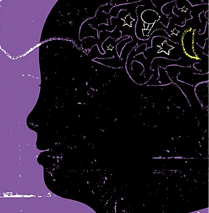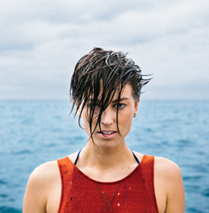The usual categories don’t apply when describing COLLINS. “Branding agency” isn’t distinctive enough. There are lots of them on lists like the “100 largest” and “50 best.” Design firm or studio sounds too last century. Ad agency is just plain wrong.

So why not define COLLINS by its awards and accolades? As just a few examples: Ad Age’s “Design Agency of the Year” three years in a row. Seven pencils at the 2021 British D&AD Awards, with another “Design Agency of the Year” ranking. Listed in “The Top 50 Companies Where Creatives Want to Work Next” alongside Apple, Google and Pixar. And, always, multiple awards from AIGA, Communication Arts, The One Show and the Type Directors Club.
Browse Projects
“We are a community. Not a company. Not a firm,” says cofounder and chief creative officer Brian Collins. Barely post-pandemic, at the height of a hot summer and with the COLLINS team scattered around the globe, we begin our conversations via FaceTime. He’s in Woods Hole, Massachusetts, where he’s visibly excited about the almost-completed “Camp COLLINS” retreat facility. “This is where we can get together and work on enormous projects,” he says, giving me a virtual tour. “It’s on five acres of woods with hiking trails and a pond near Buckminster Fuller’s oldest surviving geodesic dome and the Oceanographic Institute. The house was built in 1870 with a modernist addition from the ’60s, three levels of decks, six bedrooms and a painting studio. The worktable and kitchen table are across from each other, he points out: “We’ll cook and enjoy meals together. Powerful conversations happen when you’re doing the dishes.”
“In-person interaction can’t be duplicated,” agrees vice president and creative director L.A. Corrall. “We love being around and with each other.” Corrall formerly worked on-site with Apple teams in Sunnyvale and Cupertino but, like all 60 members of the COLLINS community, quickly attained fluency at collaborating over time zones and borders via Zoom.
So where is COLLINS actually located? Perhaps the correct answer is all over the place. There are two physical offices: a two-story building on a Brooklyn residential street and a former warehouse in San Francisco’s SoMa district. When I visit the Brooklyn space, a few people are working in the drop-in studio/conference room, but I have the kitchen; the upstairs hookah lounge with its comfy sofa cushions; and the 20,000-volume, floor-to-ceiling library—where many projects begin with a team meeting—all to myself. There, I ponder the juxtapositions: Paul Rand’s A Designer’s Art and Richard Poulin’s Typography, Referenced are tucked between a collection of essays by bell hooks, a volume of poetry by Robert Frost and an early illustrated edition of The Wonderful Wizard of Oz.
Where is everybody? Besides New York and San Francisco, they’re working in various locations in Australia, Europe and North America. When I meet fifteen of them on Zoom, I learn they come from diverse places including Hong Kong, India, Lithuania, North Carolina, Poland, Thailand and South Africa. Some had traditional educations at top American and European art schools. Others graduated from public and private universities. Some left for the professional world before finishing their degrees. Coming to COLLINS might have been their first job right out of school, the next step after completing a prestigious internship, or a considered move after several years at an international design firm, Nike or VICE Media.
Or they might have been recruited from a different place in life altogether. Business director Antonia Lazar, who’s been managing COLLINS’s client relationships for seven years, previously headed customer service at indoor tennis facilities in San Francisco and Chicago. “I never worked in the branding or advertising space before,” she says. “For 29 years, I only knew tennis. I was all things tennis.” At the time, her resume included “strengthened relationships through personalized invitations to explore the lifestyle the clubs provided” and “singlehandedly landed and maintained the largest corporate account companywide to date.” Every agency or studio needs skills like these, even if they might not realize it. Lazar began as Collins’s and Maschmeyer’s executive assistant, managing their calendars, and quickly got promoted to client liaison on The Jim Henson Exhibition at New York’s Museum of the Moving Image. Completed in 2016, the exhibit is the archetypical COLLINS project: complex, colorful, witty, sophisticated and evergreen.
Wait, Collins and Maschmeyer’s executive assistant? Yes. Leland Maschmeyer, cofounder and chief executive officer. He attended the University of North Carolina at Chapel Hill and, while working as an account executive at a North Carolina–based ad agency, wrote a blog that, as he put it, “exercised both sides of my brain, systems engineering and poetry, and took a broad view of design with a capital D,” including architecture, information, advertising, cybernetics, physics and, of course, branding. While Maschmeyer was doing freelance art direction on the side of his agency job, Collins was heading up the Brand Integration Group at Ogilvy & Mather—and becoming his biggest fan. In 2007, Collins invited Maschmeyer to join him for breakfast. The conversation lasted four hours and ended with the following exchange:
“Let’s stay in touch.”
“Why don’t we start a design firm together?”
After ten years at what he calls “the finest ad agency in the world,” Collins was ready to leave Ogilvy & Mather. “I was overdue to make a leap,” he admits. “Ogilvy harnesses the power of story to transform brands. After meeting Leland, I realized that we could integrate the promise of story with the performance of design. Brand could drive business itself, not only to communicate value, but to create value.”
COLLINS’s doors opened in 2008 with one client, former US vice president Al Gore’s Alliance for Climate Protection campaign. The logo, a visual pun on the words we and me, was intended to motivate every American to do something about climate change.
But wait, what about Maschmeyer? “If you founded the firm together fifteen years ago,” I ask him, “why isn’t your name on the door?” The answer: “Brian was already famous. My name is hard to pronounce. Collins is easy to pronounce. We focus on outcomes, not egos.”
Maschmeyer describes his chief executive officer role as “running the business of the business, the financial operations, the cash flow and P&L.” He got his virtual MBA while taking a sabbatical from COLLINS to become chief brand officer at yogurt brand Chobani. “In-house was not considered a desirable place to work,” he explains. “I wanted to build [Chobani’s] in-house department as a gold standard, to show how design could lead a business transformation from the inside. I brought back that knowledge, which was the key ingredient other branding agencies were missing.” He sums up his role as “designing the COLLINS business as an organization for growth.”
Could that growth include opening offices in other cities, establishing a presence in Asia or Europe? It’s already happening, but not by opening offices in the traditional sense. Designer Astrid Stavro had been a partner at Pentagram’s London office for three years, then left to run her own studio. She became a vice president and creative director of COLLINS this past summer, assisting the firm’s European clientele. “It felt like home right away,” she tells me. “I’m the European outpost of COLLINS, so there’s no need to rent more space. And I’m working on super-exciting projects with exceptional, amazing talent.”
No matter whom you talk to, the phrases “super-exciting projects” and “exceptional, amazing talent” come up over and over. “We have talents from around the world—great talent, great craft, great community,” says COLLINS’s senior designer Zuzanna Rogatty, who earned her MFA at the University of Fine Arts Poznań, Poland, and now lives in Hawai‘i. “Everyone is different. We celebrate those differences. That’s why every project comes out very differently.”
It’s true. Everyone has a favorite project, from the new Match.com persona, “the grownup in the room of dating apps,” with its pastel gradients and bedside still lifes; to the elegant, tactile packaging for Crane papers; the young green vibe of the Robinhood app that promises to make investing accessible to everyone; and the work for the San Francisco Symphony that typographically visualizes the rising crescendos of music.
For design director Sanuk Kim, originally from South Korea and now living in Boston, COLLINS “amplifies everyone’s voice so the end product resonates with massive global audiences.” COLLINS was Kim’s first official job. “Every team typically includes a project manager, business director, strategy director, creative director, copywriter, three designers, motion designer,” she explains. “Everyone presents sketches. After we identify the most exciting opportunities, multiple creative directions are edited and brought together for the creative director to present to the client. There’s no sense of competition or ego.”
What if the client isn’t 100-percent sold on the direction, which may be significantly bolder than what they’re used to seeing? Such is the case with COLLINS’s daring removal of the silhouettes from the venerable Girl Scouts of America trefoil symbol. “Our job is to challenge and inspire people,” Maschmeyer says, “to help them evolve.” Later, Collins adds: “We don’t pitch or make presentations. We have conversations.”
Those conversations go way deeper than how a brand looks and feels. They’re about every aspect of how it’s led, managed and perceived, according to Maschmeyer, redefining it and bringing it into the present and future. Design director Jump Jirakaweekul cited the CNET project: “The design brief was something like, ‘We need to branch out but aren’t exactly sure how.’ We worked with them to move into a larger space with a new strategy, a bigger opportunity, the right language and then airbrushed ’80s-style illustrations.” Now, CNET is “your guide to a better future” that can help with all aspects of your life. The CNET logo, which morphed from condensed to extra-bold, moves in a particularly striking way.
Although the WE ARE COLLINS brand itself is known for crediting every person on every team—shining the spotlight on the newest, youngest hires—Tomas Markevicius is most often credited as the genius behind the animations. “Motion is my discipline,” says the Lithuanian-born-and-educated motion design director. “It’s not only animation, like film titles; it’s what happens when a static logo starts to move and tell its story. All brands live in a digital environment and need to behave on outdoor screens, phone apps and especially in the greeting moment, how the brand greets you when you open it, he says (like everyone I spoke to at COLLINS, without ‘ums,’ ‘likes’ or ‘you knows’) we establish principles and leave clients with an animated guidelines manual with hyperlinks to watch the moving pieces.”
“Guidelines don’t replace talent,” adds Alex Blumfelder, vice president of program management. “We guide them from the inside out, which can include advising them on how to build their internal creative teams.”
The conversations ultimately circle back to Collins and The Alliance for Climate Protection. “The organization needed a simple graphic idea that would cross every boundary and political view,” he says. “I took it from a passage from Gore’s book, Assault on Reason: Our first expression as a nation—We the People—made it clear where the ultimate source of authority lay. In the opening phrase of the US Constitution, we found our inspiration: The idea of ‘me’—and personal initiative—lives inside the idea of ‘we.’ We have to work together to solve the climate crisis, and we have to call, loudly, for our political and business leaders to take the lead. I’d hoped this was both a clever and profound expression of the campaign’s ambition. It forces the reader to decipher a word game and, once accomplished, makes the logo more memorable. Fifteen years later, with climate change an everyday conversation, it works better than ever. And it kicked us off in the right direction.”
Right now, creative director Joseph Han is wrapping his mind around rebranding the IIT Institute of Design (ID) at the Illinois Institute of Technology, founded in 1936 by László Moholy-Nagy as The New Bauhaus. “We’re developing a typographic system for ID,” he says, “based on intersecting modules representing UI, UX, architecture, art, design thinking and addressing problems like world hunger.”
How will COLLINS visualize that? We’ll have to wait and see. ca














































